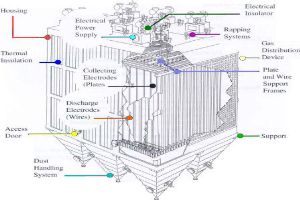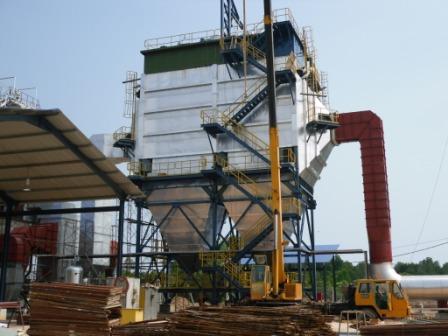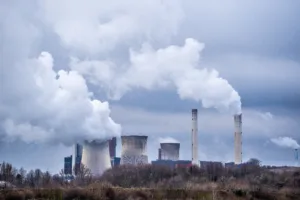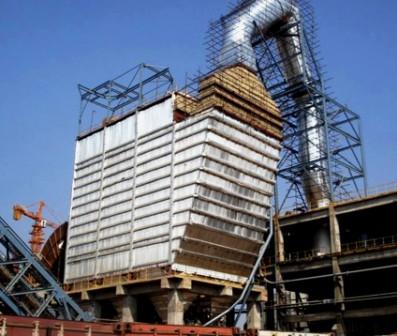-
Electrostatic Precipitators
-
Reverse Air Bag Houses
-
Fabric filters
-
Hybrid electro filters
-
Flue Gas Desulphurization
-
Forced draught cooler
-
Scrubbers
-
Gas cleaning plants
-
Cyclones
-
Multiclones
-
VOC + Odour removal system
-
Dust extraction system
-
Fumes extraction system
-
Explosion protection devices
-
Fans and blowers
-
Waste water treatment
-
Air to Air Heat Exchanger
Electrostatic Precipitators
An electrostatic Precipitator or electrostatic air cleaner is a filterless device that is used to remove impurities or fine particles from a flowing gas. It uses an electric charge to remove tiny solid impurities or liquid droplets from the air or gases in smokestacks and other flues. Due to the electrical forces, the particles move from the air stream to the collection plates. Particles passing through the precipitator are given a negative electrical charge by being forced to pass through a region, called a corona, where the gas ions flow. When the particle becomes negatively charged, it is then forced towards the positively charged plate. With the help of a knocking action, particles are removed from the plate.
An electrostatic precipitator is a large, industrial emission-control unit. It is designed to trap and remove dust particles from the exhaust gas stream of an industrial process. Precipitators are used in these industries:
- Power/Electric
- Cement
- Chemicals
- Metals
- Paper

In many industrial plants, particulate matter created in the industrial process is carried as dust in the hot exhaust gases. These dust-laden gases pass through an electrostatic precipitator that collects most of the dust. Cleaned gas then passes out of the precipitator and through a stack to the atmosphere. Precipitators typically collect 99.9% or more of the dust from the gas stream.
Depending upon dust characteristics and the gas volume to be treated, there are many different sizes, types and designs of electrostatic precipitators. Very large power plants may actually have multiple precipitators for each unit.
Electrostatic precipitators were originally designed for recovering valuable industrial process materials. But now, these precipitators are used for air pollution control at industrial facilities and power generating stations. They are primarily used for removing harmful particulate matter from waste gases. These particulates have several adverse effects if released into the atmosphere. They can reduce visibility, contribute to climate change, and lead to serious health problems in humans, including lung damage and bronchitis. Though the initial cost of ESPs is a little higher than local exhaust ventilation systems, owing to the multiple advantages, it becomes worth considering. ESPs require very little maintenance after installation because there are no moving parts. The installation time and cost of operation are also less as compared to a local exhaust ventilation system. One more advantage is that the product is easily recovered and recycled back into the process.
Principle of Our ESP:
Electrostatic Precipitators use electric forces to separate suspended particles from gases. This is carried out in two basic steps:
- A corona-charging field provides the particles with an electrical charge.
- A high-voltage collecting field attracts the charged particles to the collecting electrodes.
The treated air is then released into the atmosphere through the stack. When sufficient particles get deposited on the collection devices, mechanical rappers are used to shake the particles off the collectors. These tiny particles, which can be dry or wet, fall into the hopper and are transported away for disposal through a conveyor system.
The most common commercial electrostatic precipitators are designed with a row of thin vertical wires and a stack of large flat vertical metal plates. The spacing between these plates varies from less than 1.3 cm (0.5 inches) to about 17.8 cm (7 inches). The gas stream flows horizontally between the wires and through the stack of plates. To remove impurities from the gas stream, a negative charge of several thousand volts is transmitted between the wires and plates.
The plates of the Plate Precipitators can be sometimes difficult to clean and can also produce ozone and nitrogen oxides. Some precipitation filters are provided with special soak-off cleaners that allow the entire plate array to be removed and soaked for several hours, which loosens the particulates. A high voltage is applied to the discharge electrode that generates a corona discharge which produces minus ions. Electrically charged dust is accumulated on the collecting electrode by an electrical field. The accumulated dust is removed by rapping hammer (dry ESP), scraping brush (dry ESP), or flushing water (wet ESP).
Differentiation of Wet ESP and Dry ESP
Dry electrostatic precipitator ( ESP )
These types of precipitators are employed on hot process exhausts (250 – 850 deg. F) that operate above the dew point of the gas stream. They majorly collect dust particles such as wood ash, incinerator ash, or coal ash from boiler or incinerator applications. Some other dry electrostatic precipitator applications include carbon anode ovens, cement kilns, and petroleum cat crackers. Dry ESPs are more widely used due to the fact that they collect and transport dust in dry conditions. This eliminates the use of water and the concerns of pollution, corrosion, and dewatering efforts associated with scrubbers. If the dust particles can be collected and managed in a dry condition it is always advisable to install a Dry ESP.
Wet electrostatic precipitator ( WESP )
Dry ESPs can achieve a 99+% collection efficiency for coarse and fine particulate removal but lacks efficiency in removing moist or sticky particulate that would stick to the collection surface Wet Electrostatic Precipitators in exhaust systems can be used for materials that contain wet, sticky, tar-like, tacky or oily particulates. Wet ESPs employ an old technology designed in the 1920s to collect sulfuric acid mist using lead collection tubes. In today’s time, WESPs are employed on gas streams that include oily and sticky particulates or gas streams that must be cooled to saturation in order to condense aerosols that were formerly in the gas phase.
Dust Collection Performance and Dust Characteristics
Our accumulated know-how in evaluating characteristic assessments on various dust properties and flue gas conditions, together with extensive field experience, are reflected in the ESP design.
ESP Performance Improvements to counter High-Resistivity Dust
The most important consideration in baghouse filter electrostatic precipitators and scrubbers is to maintain and increase the dust collecting performance of high-resistivity dust. Several measures to compete high-resistivity dust have been established.
Our technologies are shown in the following table. We offer suitable technologies for plant applications and operations and can realize both compact design and high efficiency.
APPLICATIONS
Electrostatic precipitators are the major devices in the process of cleaning up flue gases. They are highly effective at reducing particle pollution, including those particles whose sizes are approximately 1 micron (0.00004 inches) in diameter, and some precipitators can remove particles of 0.01 microns in diameter. Precipitators can very easily work with a large volume of gases at varied temperatures and flow rates which helps in removing both solid and liquid particles.
There are several electrostatic precipitator manufacturers in India who come up with the product in various sizes and types, designed for various dust and water droplet characteristics and gas volume flows. Some ESPs are designed to work with a gas stream with particular temperature and moisture characteristics. In order to get rid of impurities from smoke and dust, Dry electrostatic precipitators generally operate above the dew point of the gas. Contrary to this, Wet precipitators are mostly used to remove liquid droplets, including oil, resin, tar, and sulfuric acid mist, from gas streams in industrial settings. They are applied where the gases are laden with humidity, contain combustible particulates, or have particles that can be sticky and cannot be removed using dry electrostatic precipitators.
The large power plants may also own multiple precipitators for each unit. Residences on the other hand may have a single precipitator, which is only slightly larger than a household vacuum cleaner. Some precipitators are efficient enough to collect 99.9 percent or more of the dust (which can contain arsenic, acids, and other chemicals) from the gas exhaust. However, this majorly depends on the temperature and flow rate of the gas, the size and chemical composition of the particles, and the precipitator design and voltage it applies to the gas. They have been used in the following industrial applications:
- Removing dirt from flue gases in steam plants
- Removing oil mists in machine shops
- Removing acid mists in chemical process plants
- Cleaning blast furnace gases
- Removing bacteria and fungi in medical settings and pharmaceutical production facilities
- Purifying the air in ventilation and air conditioning systems
- Material recovery from gas flow (including oxides of copper, lead, and tin)
- Separating rutile from zirconium sand in dry mills and rutile recovery plants

PROCESS
Electrostatic precipitation removes particles from the exhaust gas stream of an industrial process. Often the process involves combustion, but it can be any industrial process that would otherwise emit particles to the atmosphere. Six activities typically take place:
An electrostatic precipitator is a large, industrial emission-control unit. It is designed to trap and remove dust particles from the exhaust gas stream of an industrial process. Precipitators are used in these industries:
- Ionization – Charging of particles
- Migration – Transporting the charged particles to the collecting surfaces
- Collection – Precipitation of the charged particles onto the collecting surfaces
- Particle Dislodging – Removing the particles from the collecting surface to the hopper
- Particle Removal – Conveying the particles from the hopper to a disposal point.
The major precipitator components that accomplish these activities are as follows:
- Discharge Electrodes
- Power Components
- Precipitator Controls
- Rapping Systems
- Purge Air Systems
- Flue Gas Conditioning
- Modeled ESP’s to ensure proper gas distribution inside ESP
- Rigid Multi spike Discharge electrode for steady corona generation & ideal for high resistive dust.
- Sigma profile Collecting electrode ensuring rigidity & quiescent zone to minimize re-entrainment.
- Suitable for high applied Kv-110 Kv (Peak)Microprocessor based rapping control system which is in-built with TR controller
- Penthouse design ESP, to ease maintenance under all-weather condition
- Pressurized air heating system to optimize operating power consumption & enhance longevity of insulators
- Availability of ESP is near to cent %.
- Opacity based control system.
Special design features
The salient features of the ESP’s we offer include:
- Horizontal and vertical flow precipitators.
- Designs for gas volumes, from as little as 10000 m3/hr. to 20,00,000 m3/hr.
- Hot gas designs for operation at temperatures above 5000C.
- ESPs for diverse applications like corrosive gas, tar and other difficult material, etc.
- Expertise of both bottom as well as top rapping.



;)